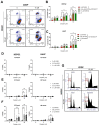Synergistic Effects of Sanglifehrin-Based Cyclophilin Inhibitor NV651 with Cisplatin in Hepatocellular Carcinoma
- PMID: 36230472
- PMCID: PMC9559492
- DOI: 10.3390/cancers14194553
Synergistic Effects of Sanglifehrin-Based Cyclophilin Inhibitor NV651 with Cisplatin in Hepatocellular Carcinoma
Abstract
Hepatocellular carcinoma (HCC), commonly diagnosed at an advanced stage, is the most common primary liver cancer. Owing to a lack of effective HCC treatments and the commonly acquired chemoresistance, novel therapies need to be investigated. Cyclophilins-intracellular proteins with peptidyl-prolyl isomerase activity-have been shown to play a key role in therapy resistance and cell proliferation. Here, we aimed to evaluate changes in the gene expression of HCC cells caused by cyclophilin inhibition in order to explore suitable combination treatment approaches, including the use of chemoagents, such as cisplatin. Our results show that the novel cyclophilin inhibitor NV651 decreases the expression of genes involved in several pathways related to the cancer cell cycle and DNA repair. We evaluated the potential synergistic effect of NV651 in combination with other treatments used against HCC in cisplatin-sensitive cells. NV651 showed a synergistic effect in inhibiting cell proliferation, with a significant increase in intrinsic apoptosis in combination with the DNA crosslinking agent cisplatin. This combination also affected cell cycle progression and reduced the capacity of the cell to repair DNA in comparison with a single treatment with cisplatin. Based on these results, we believe that the combination of cisplatin and NV651 may provide a novel approach to HCC treatment.
Keywords: PPIase; apoptosis; cisplatin; cyclophilin; hepatocellular carcinoma; synergy.
Conflict of interest statement
S.S.S., M.T., A.G., E.E. and M.J.H. are or have been employees of Abliva AB, which holds the commercial rights to NV651. S.S.S., A.G., E.E. and M.J.H. own shares in Abliva AB. J.M., C.K., P.G. and R.M. declare no potential conflict of interest.
Figures






References
-
- World Health Organization Liver Fact Sheet. 2020. [(accessed on 1 November 2021)]. Available online: https://gco.iarc.fr/today/data/factsheets/cancers/11-Liver-fact-sheet.pdf.
Grants and funding
LinkOut - more resources
Full Text Sources

